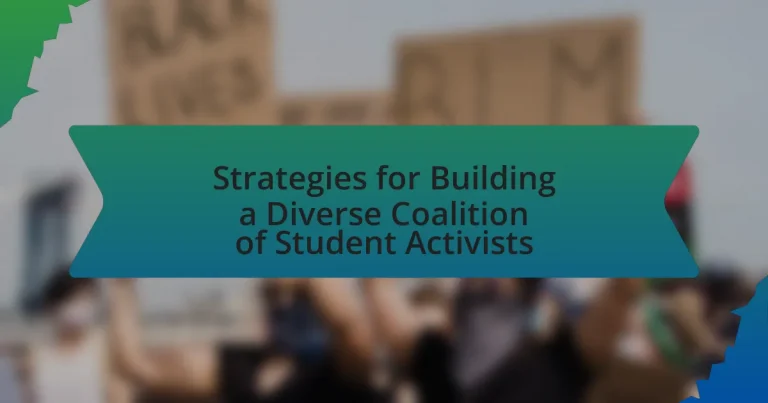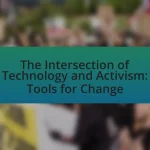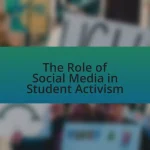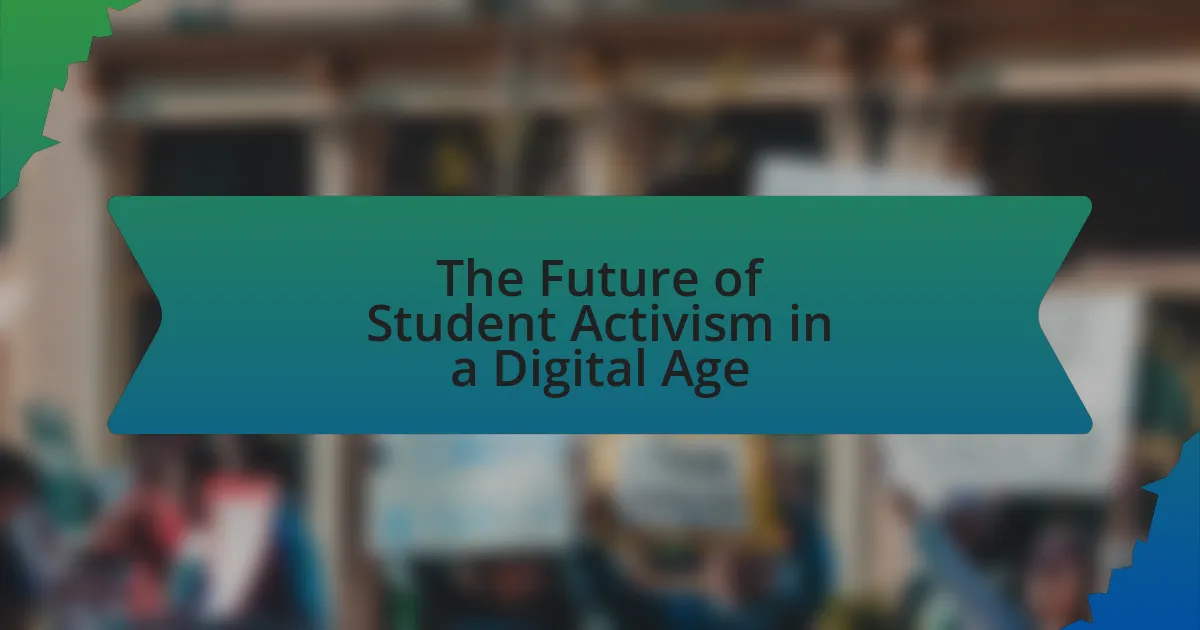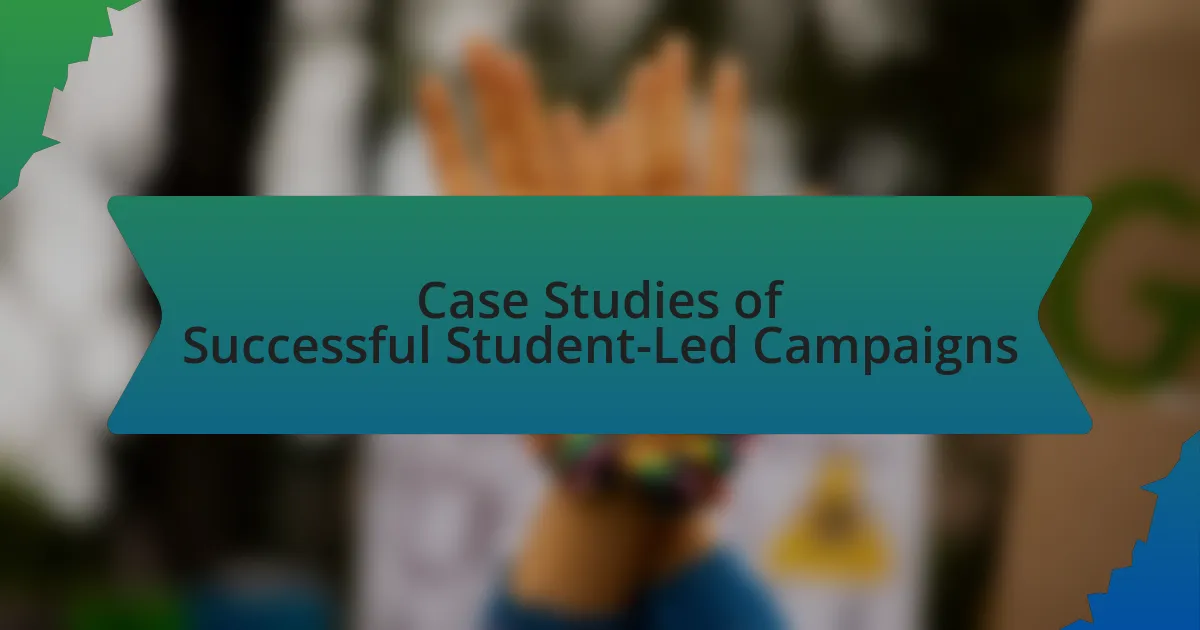The article focuses on strategies for building a diverse coalition of student activists, emphasizing the importance of inclusive communication, shared goals, and a welcoming environment. It discusses how understanding intersectionality can enhance coalition-building by recognizing the diverse identities and experiences within a group, leading to more effective advocacy. The article also addresses the significance of inclusivity in activism, the benefits of diverse perspectives, and methods for recruiting diverse members. Additionally, it explores challenges in coalition-building, strategies for conflict resolution, and best practices for sustaining engagement among members, ultimately highlighting the role of institutional support and ongoing education in fostering a successful and diverse activist coalition.
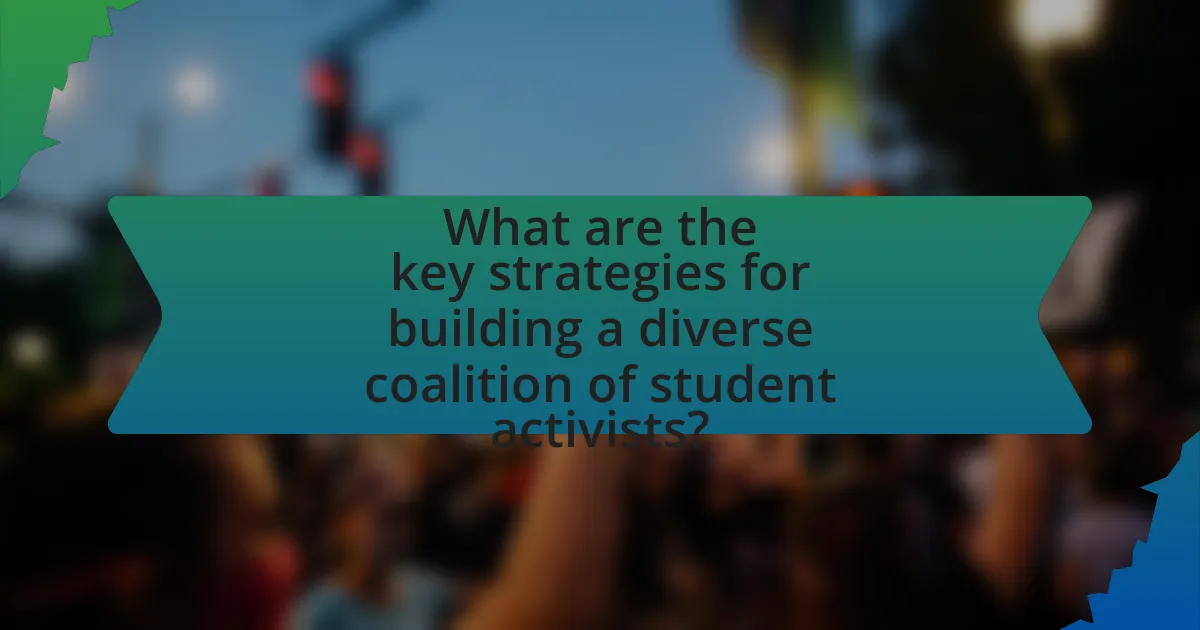
What are the key strategies for building a diverse coalition of student activists?
The key strategies for building a diverse coalition of student activists include fostering inclusive communication, establishing shared goals, and creating a welcoming environment. Inclusive communication ensures that all voices are heard and valued, which can be achieved through regular meetings and open forums that encourage participation from various backgrounds. Establishing shared goals aligns the coalition’s efforts and motivates members to work together, as seen in successful movements like the March for Our Lives, where diverse groups united for common objectives. Creating a welcoming environment involves actively addressing barriers to participation, such as accessibility and cultural sensitivity, which can enhance engagement and representation. These strategies are supported by research indicating that diverse coalitions are more effective in achieving social change due to their varied perspectives and experiences.
How can understanding intersectionality enhance coalition-building?
Understanding intersectionality enhances coalition-building by recognizing and addressing the diverse identities and experiences within a group. This approach fosters inclusivity, allowing coalition members to appreciate how overlapping social identities—such as race, gender, sexuality, and class—impact individuals’ experiences and challenges. Research by Crenshaw (1989) highlights that acknowledging these intersections can lead to more effective advocacy strategies, as it ensures that the needs of all members are considered, ultimately strengthening the coalition’s unity and effectiveness in addressing systemic issues.
What role does intersectionality play in identifying common goals?
Intersectionality plays a crucial role in identifying common goals by highlighting the interconnected nature of social categorizations such as race, gender, and class, which can create overlapping systems of discrimination or disadvantage. This framework allows activists to recognize that individuals experience oppression differently based on their unique identities, thus fostering a more inclusive approach to coalition-building. For instance, research by Crenshaw (1989) emphasizes that understanding these intersections can lead to more effective advocacy strategies that address the specific needs of diverse groups, ultimately uniting them around shared objectives. By acknowledging and addressing these complexities, coalitions can develop common goals that resonate with a broader spectrum of experiences, enhancing solidarity and collective action.
How can intersectionality inform outreach efforts to diverse groups?
Intersectionality can inform outreach efforts to diverse groups by highlighting the interconnected nature of social identities and the unique challenges faced by individuals at these intersections. This understanding allows outreach programs to tailor their strategies to address specific needs, ensuring that marginalized voices are included and represented. For example, research by Crenshaw (1989) emphasizes that individuals who belong to multiple marginalized groups experience discrimination in ways that are not fully captured by single-axis frameworks. By applying an intersectional lens, outreach initiatives can develop targeted messaging and resources that resonate with various identities, ultimately fostering a more inclusive and effective coalition of student activists.
Why is inclusivity important in student activism coalitions?
Inclusivity is crucial in student activism coalitions because it ensures diverse perspectives and experiences are represented, leading to more effective advocacy. When coalitions include individuals from various backgrounds, they can address a wider range of issues and create solutions that resonate with a broader audience. Research indicates that diverse groups are more innovative and better at problem-solving, as they draw on a variety of viewpoints and experiences. For instance, a study published in the Harvard Business Review found that teams with diverse members outperform homogenous teams in decision-making and creativity. Therefore, inclusivity not only strengthens the coalition but also enhances its impact on social change.
What are the benefits of having diverse perspectives in activism?
Diverse perspectives in activism enhance creativity, problem-solving, and inclusivity. When individuals from various backgrounds collaborate, they bring unique experiences and viewpoints that can lead to innovative strategies and solutions. Research indicates that diverse teams are more effective in addressing complex social issues, as they can identify a wider range of potential solutions and anticipate different reactions from various community segments. For example, a study published in the Harvard Business Review found that diverse groups outperform homogenous ones in decision-making tasks, demonstrating that varied perspectives lead to better outcomes in activism efforts.
How can inclusivity improve the effectiveness of campaigns?
Inclusivity can improve the effectiveness of campaigns by ensuring that diverse perspectives are represented, which enhances creativity and problem-solving. When campaigns incorporate voices from various backgrounds, they can better address the needs and concerns of a broader audience, leading to increased engagement and support. Research indicates that diverse teams are 35% more likely to outperform their homogeneous counterparts in terms of innovation and decision-making, as highlighted in a study by McKinsey & Company. This diversity not only fosters a sense of belonging among participants but also amplifies the campaign’s reach and impact, ultimately driving more successful outcomes.
What methods can be used to recruit diverse members?
To recruit diverse members, organizations can implement targeted outreach strategies, inclusive messaging, and partnerships with community groups. Targeted outreach involves identifying and engaging with underrepresented communities through tailored communication channels, such as social media platforms popular among specific demographics. Inclusive messaging ensures that recruitment materials reflect diversity and emphasize the value of varied perspectives, which can attract a broader audience. Additionally, forming partnerships with local community organizations can facilitate access to diverse networks, enhancing recruitment efforts. Research indicates that organizations employing these methods see increased diversity in their membership, as they actively engage with and address the needs of various communities.
How can social media be leveraged for outreach to underrepresented groups?
Social media can be leveraged for outreach to underrepresented groups by creating targeted campaigns that resonate with their specific interests and needs. Platforms like Facebook, Twitter, and Instagram allow organizations to share tailored content, engage in conversations, and build communities around shared experiences. For instance, studies show that 69% of adults in the U.S. use social media, making it a powerful tool for reaching diverse demographics. Additionally, using hashtags relevant to underrepresented communities can increase visibility and foster connections, as evidenced by movements like #BlackLivesMatter, which effectively mobilized support and awareness through social media channels.
What partnerships can enhance recruitment efforts?
Collaborations with local businesses, educational institutions, and community organizations can enhance recruitment efforts. These partnerships provide access to diverse talent pools, resources, and networks that can attract a wider range of candidates. For instance, partnering with universities allows organizations to tap into student organizations and career fairs, increasing visibility among potential recruits. Additionally, community organizations often have established relationships with underrepresented groups, facilitating outreach and engagement. Research indicates that organizations with strong community ties see a 30% increase in recruitment effectiveness, demonstrating the value of these strategic partnerships.
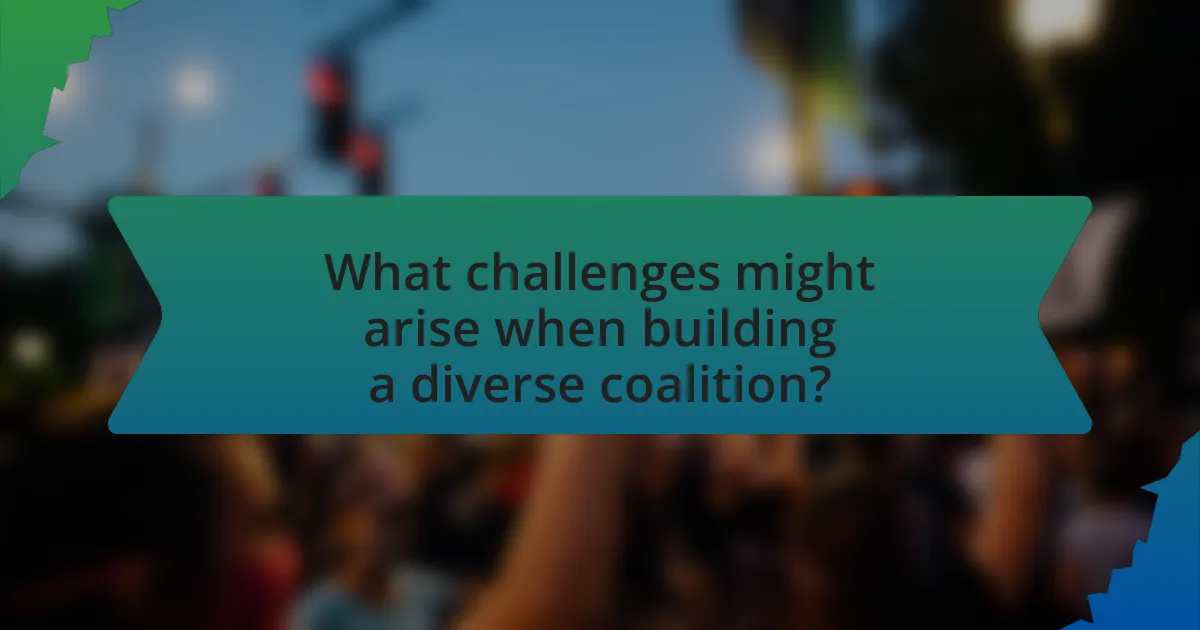
What challenges might arise when building a diverse coalition?
Building a diverse coalition can present challenges such as differing priorities, communication barriers, and potential conflicts arising from varied cultural perspectives. These challenges stem from the necessity to reconcile the unique goals and values of each group involved, which can lead to misunderstandings or a lack of cohesion. For instance, research by the American Psychological Association indicates that diverse teams may experience initial friction due to differing viewpoints, but this can be mitigated through effective communication strategies and inclusive practices. Additionally, the complexity of navigating power dynamics and ensuring equitable participation can further complicate coalition-building efforts.
How can differing priorities among members be addressed?
Differing priorities among members can be addressed through open communication and collaborative goal-setting. Establishing regular meetings where members can express their priorities fosters an environment of transparency and understanding. Research indicates that groups that engage in structured dialogue about their goals are more likely to align their efforts effectively, as seen in studies on team dynamics published in the Journal of Applied Psychology. By facilitating discussions that prioritize collective objectives, members can negotiate and find common ground, ensuring that individual priorities are acknowledged while working towards shared goals.
What strategies can facilitate dialogue among diverse viewpoints?
Facilitating dialogue among diverse viewpoints can be achieved through active listening, structured discussions, and creating safe spaces for expression. Active listening ensures that participants feel heard and understood, which fosters respect and openness. Structured discussions, such as using a facilitator to guide conversations, help maintain focus and encourage participation from all voices. Creating safe spaces allows individuals to express their thoughts without fear of judgment, promoting honest and constructive dialogue. Research indicates that these strategies lead to more productive conversations and greater understanding among participants, as evidenced by studies showing improved collaboration in diverse groups when these methods are employed.
How can conflict resolution be effectively managed in coalitions?
Conflict resolution can be effectively managed in coalitions by establishing clear communication channels and fostering a culture of collaboration. Clear communication allows coalition members to express their concerns and perspectives openly, which is essential for identifying the root causes of conflicts. Fostering collaboration encourages members to work together towards common goals, reducing the likelihood of misunderstandings and disputes. Research indicates that coalitions with structured conflict resolution processes, such as mediation and negotiation, are more successful in maintaining unity and achieving their objectives. For instance, a study published in the Journal of Conflict Resolution highlights that coalitions that implement regular feedback mechanisms and conflict resolution training experience fewer conflicts and improved member satisfaction.
What barriers exist to participation in student activism?
Barriers to participation in student activism include lack of time, fear of repercussions, and limited access to resources. Many students juggle academic responsibilities, part-time jobs, and personal commitments, which restrict their ability to engage in activism. Additionally, concerns about potential backlash from peers, faculty, or administration can deter students from participating. Research indicates that marginalized groups often face heightened risks, such as discrimination or social ostracism, which further complicates their involvement. Furthermore, inadequate access to information, funding, and organizational support can hinder students’ ability to mobilize effectively, as highlighted in studies on student engagement and activism.
How can accessibility issues be identified and addressed?
Accessibility issues can be identified through user testing, accessibility audits, and feedback from individuals with disabilities. User testing involves observing how people with various disabilities interact with a space or digital platform, revealing specific barriers they encounter. Accessibility audits systematically evaluate compliance with standards such as the Web Content Accessibility Guidelines (WCAG), highlighting areas needing improvement. Feedback from individuals with disabilities provides firsthand insights into their experiences, ensuring that solutions are relevant and effective. Addressing these issues involves implementing changes based on findings from these methods, such as redesigning spaces for physical accessibility or enhancing digital content to meet accessibility standards.
What role does institutional support play in overcoming barriers?
Institutional support plays a crucial role in overcoming barriers by providing resources, guidance, and legitimacy to student activists. This support can manifest through funding, access to facilities, and mentorship, which empower diverse coalitions to effectively organize and advocate for their causes. For instance, research indicates that institutions that actively engage in supporting student-led initiatives see higher levels of participation and success in activism, as evidenced by the increased mobilization of underrepresented groups in various campaigns. Such backing not only enhances the visibility of student efforts but also fosters an inclusive environment where diverse voices can collaborate and address systemic issues.
How can coalitions sustain engagement among diverse members?
Coalitions can sustain engagement among diverse members by fostering inclusive communication and creating shared goals. Inclusive communication ensures that all voices are heard and valued, which can be achieved through regular meetings, feedback mechanisms, and collaborative platforms that accommodate different perspectives. Creating shared goals aligns the interests of diverse members, promoting a sense of ownership and commitment to the coalition’s mission. Research indicates that coalitions with clearly defined, collective objectives experience higher levels of member engagement and satisfaction, as seen in studies conducted by the National Coalition for Dialogue & Deliberation, which highlight the importance of shared purpose in maintaining active participation.
What practices can foster a sense of belonging within the coalition?
Practices that can foster a sense of belonging within the coalition include creating inclusive spaces for dialogue, promoting shared goals, and recognizing individual contributions. Inclusive spaces for dialogue, such as regular meetings and open forums, allow members to express their thoughts and experiences, which enhances connection. Promoting shared goals aligns the coalition’s efforts and reinforces a collective identity, making members feel part of a larger purpose. Recognizing individual contributions, through acknowledgment in meetings or public forums, validates each member’s role and fosters appreciation, which strengthens interpersonal bonds. These practices are supported by research indicating that inclusive environments lead to higher engagement and satisfaction among group members.
How can regular feedback mechanisms improve coalition dynamics?
Regular feedback mechanisms can significantly enhance coalition dynamics by fostering open communication and trust among members. These mechanisms allow coalition participants to express their perspectives, address concerns, and collaboratively refine strategies, which leads to increased engagement and commitment. Research indicates that organizations with structured feedback processes experience higher levels of satisfaction and effectiveness, as members feel valued and heard. For instance, a study published in the Journal of Organizational Behavior found that teams that implemented regular feedback sessions reported improved collaboration and problem-solving abilities, demonstrating the positive impact of feedback on group dynamics.

What are best practices for maintaining a diverse coalition of student activists?
Best practices for maintaining a diverse coalition of student activists include fostering open communication, ensuring inclusive decision-making, and providing equitable access to resources. Open communication allows for the sharing of diverse perspectives, which strengthens the coalition’s unity and effectiveness. Inclusive decision-making ensures that all voices are heard and valued, promoting a sense of belonging among members. Providing equitable access to resources, such as funding and training, empowers all activists, regardless of their background, to contribute meaningfully to the coalition’s goals. These practices are supported by research indicating that diverse groups are more innovative and effective in problem-solving, as highlighted in studies by the Harvard Business Review.
How can ongoing education about diversity and inclusion be implemented?
Ongoing education about diversity and inclusion can be implemented through structured training programs, workshops, and continuous learning opportunities. Educational institutions can establish mandatory diversity training sessions that cover topics such as unconscious bias, cultural competency, and inclusive practices. Research indicates that organizations with regular diversity training see a 33% increase in employee engagement and a 20% improvement in team collaboration (Deloitte, 2020). Additionally, integrating diversity and inclusion topics into the curriculum and promoting student-led initiatives can foster an environment of ongoing dialogue and learning.
What resources are available for training coalition members?
Training coalition members can utilize various resources, including workshops, online courses, and mentorship programs. Workshops often focus on skills such as leadership, communication, and conflict resolution, which are essential for effective coalition building. Online platforms like Coursera and edX offer courses specifically designed for activism and community organizing, providing accessible education for coalition members. Additionally, mentorship programs connect experienced activists with new members, fostering knowledge transfer and practical guidance. These resources collectively enhance the capabilities of coalition members, ensuring they are well-equipped to engage in diverse activist strategies.
How can workshops and discussions be structured for maximum impact?
Workshops and discussions can be structured for maximum impact by incorporating clear objectives, diverse participation, and interactive formats. Establishing specific goals ensures that all activities align with desired outcomes, such as fostering collaboration or enhancing understanding of social issues. Engaging a diverse group of participants enriches the dialogue, as varied perspectives lead to more comprehensive solutions. Utilizing interactive formats, such as breakout sessions or hands-on activities, promotes active involvement and deeper learning. Research shows that interactive learning environments can increase retention and engagement by up to 75%, highlighting the effectiveness of these strategies in achieving impactful outcomes.
What strategies can be employed to celebrate diversity within the coalition?
To celebrate diversity within the coalition, implementing inclusive events and educational workshops is essential. These initiatives can foster understanding and appreciation of different cultures, perspectives, and experiences among coalition members. For instance, hosting cultural festivals or panel discussions featuring diverse voices can enhance awareness and promote dialogue. Research indicates that organizations that actively celebrate diversity experience increased collaboration and innovation, as highlighted in a study by McKinsey & Company, which found that diverse teams are 35% more likely to outperform their less diverse counterparts.
How can cultural events and activities enhance coalition cohesion?
Cultural events and activities enhance coalition cohesion by fostering shared experiences and mutual understanding among diverse members. These events create opportunities for individuals from different backgrounds to interact, share their cultural narratives, and build relationships, which are essential for trust and collaboration. Research indicates that participation in cultural activities can lead to increased social capital, as individuals develop networks and support systems that strengthen group dynamics. For example, a study published in the Journal of Community Psychology found that community cultural events significantly improved group cohesion and collective identity among participants, demonstrating the effectiveness of such activities in uniting diverse coalitions.
What role does recognition of individual contributions play in coalition success?
Recognition of individual contributions is crucial for coalition success as it fosters motivation, enhances collaboration, and builds trust among members. When individuals feel acknowledged for their unique skills and efforts, they are more likely to engage actively and contribute meaningfully to the coalition’s goals. Research indicates that recognition can lead to increased satisfaction and commitment, which are essential for maintaining a cohesive group dynamic. For instance, a study published in the Journal of Applied Psychology found that employee recognition significantly boosts morale and productivity, which can be extrapolated to coalition contexts where diverse contributions are vital for achieving collective objectives.
What practical tips can help in building and sustaining a diverse coalition?
To build and sustain a diverse coalition, prioritize inclusive communication and active listening to ensure all voices are heard. Establishing clear goals that reflect the interests of various groups fosters unity and purpose. Regularly engage in team-building activities that celebrate cultural differences, enhancing trust and collaboration among members. Additionally, provide training on diversity and inclusion to equip coalition members with the skills to navigate challenges effectively. Research indicates that diverse teams are more innovative and effective, as highlighted in a study by McKinsey & Company, which found that organizations with greater diversity are 35% more likely to outperform their peers.
